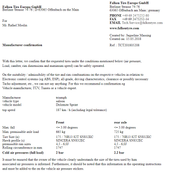Both the Triumph Toledo 1300 owners’ handbook and official BLMC Triumph Toledo 13/1500 workshop manual, specify tyre-inflation pressures of 22 psi & 26 psi for the front & rear tyres respectively, for the original factory-fitted 155 SR13 radial tyres, mounted on 4J x 13 inch steel wheels.
When my father bought the six-month old, ex-demonstrator 1974 four-door Triumph Toledo 1300 in May 1975, it had already been retro-fitted by Mann Egerton with 5½ x 13 inch Cosmic aluminium-alloy wheels and 175 SR13, Uniroyal Rallye 180, steel-braced radial tyres, but they hadn’t specified any alternative tyre pressures, for these substitute wheels & tyres.
Apart from a short period in the early-1980s, when I was experimenting with tyre pressures, my 1974 four-door Triumph Toledo 1300 has always been run with tyre-inflation pressures (as indicated on the hand-held PCL pencil-gauge or foot-pump gauge) of 22 psi & 26 psi in front & rear tyres respectively; in both 175 SR13 (aka 175/80 SR13 | Uniroyal Rallye 180 during 1975 to 1982 & Kelly-Springfield Steelmark from 1982 to 1987) and 185/70 SR13 tyres (Firestone S211 from 1987 to 1999), mounted on 5½ x 13 inch aluminium-alloy wheels.
Sometime in the early-1980s, whilst I was studying at Cranfield Institute of Technology, I learned from a fellow student who owned a Triumph Dolomite 1500, that the specified tyre-inflation pressures for the Triumph Dolomite 13/1500, were 26 psi & 30 psi for the front & rear tyres respectively; 4 psi more than for the slightly shorter and lighter-weight Triumph Toledo.
Knowing that increased tyre-inflation pressures confer more precise steering and reduced rolling resistance (i.e. reduce fuel consumption), but mindful of the uneven tyre wear associated with either under-inflation or over-inflation, I decided to try slightly increasing the inflation pressures of my Toledo’s front and rear 175 SR13, Kelly-Springfield tyres.
Not being as heavy as a Dolomite 13/1500, I opted for 24 psi & 28 psi for the front & rear tyres respectively. This certainly made the steering lighter and more responsive, but I didn’t run the car long enough with these increased inflation pressures, to discover whether they gave any statistically significant reduction in fuel consumption.
One undesirable side effect of increasing the inflation pressures, was that the car became noticeably skittish, when negotiating a particular bend (I rounded it twice a week for nearly 3½ years) whose road surface was uneven (i.e. bumps or corrugations), so I reverted to the original tyre-inflation pressures of 22 psi & 26 psi for the front & rear tyres respectively.
This skittishness was probably attributable to the increased vertical stiffness of the inflated tyres, which act as air-springs in series with the suspension’s helical coil springs, thus increasing the suspension’s overall stiffness. I also suspect that substituting ultra-low profile tyres such 185/55 R15, might similarly confer such skittishness, owing to the greater vertical stiffness of such tyres.
Each of the five 175 SR13 (aka 175/80 SR13) Kelly-Springfield Steelmark radial-ply tyres gave just over 35,000 miles of service during the period 1982 to 1987. Wherever possible, I have always tried to wear out a complete set of five tyres at approximately the same rate, by rotating the wheels around the car at each service interval.
Using tyre-inflation pressures (as indicated on the hand-held PCL pencil-gauge or foot-pump gauge) of 22 psi & 26 psi in front & rear tyres respectively, I observed no uneven tread-wear patterns which might otherwise have suggested over-inflation or under-inflation.
I was also running the front wheels at more negative camber than the factory-standard specifications, having completely removed the stacked pairs of camber-adjustment shims from between the front sub-frame and the upper portion of the front-suspension wishbone-brackets. Despite this, there was no indication of any noticeable tyre-shoulder wear.
I have also since become aware that increasing a tyre’s inflation-pressure decreases a tyre’s slip angle when subjected to a lateral force and vice versa. As a consequence of changing tyres’ slip angles, one can also change the degree of over-steer or under-steer characteristics. This is one reason why rear-engined, rear-wheel-drive vehicles have traditionally had substantially higher inflation-pressures in the rear tyres compared to those at the front, because decreasing a rear tyre’s slip angle relative to that at the front, reduces the tendency to over-steer.
At some time in the future, when I substitute 5½J x 15 inch MG Maestro aluminium-alloy wheels and either 185/65 R15, 185/60 R15 or 185/55 R15 radial-ply tyres on my 1974 Triumph Toledo 1300, I might need to reconsider what tyre inflation-pressures would be most appropriate!?!
Here's a test procedure I might try:
https://axleaddict.com/auto-repair/Chec ... ket-Wheels
|
